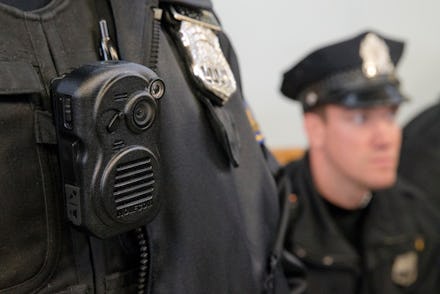Seattle Is Showing Everyone the Right Way to Use Police Body Cameras

Members of the public can now see through the eyes of a Seattle police officer — at least, if that officer happened to forget his glasses that day.
The Seattle Police Department has begun posting videos on YouTube captured by body cameras mounted on police officers' chests, using the handle SPD BodyWornVideo. The initiative is part of what department chief operating officer Mike Wagners told the Seattle Times was an effort to make "enhancing public trust a cornerstone of police reforms."
The YouTube channel strikes a balance between openness and protecting the identity of individuals caught on video by implementing automated software developed by hacker Timothy Clemans. The technique uses a Gaussian blur to remove personally identifiable facial features, allowing police to redact and send out high volumes of video in a short amount of time.
Here's a sample of the footage below, taken during a protest on Martin Luther King Jr. Day on Jan. 19:
The background: Police body cams will soon roll out all over America, thanks in large part to $263 million in federal funding to purchase an estimated 50,000 units for distribution to police forces nationwide. The push to equip officers with recording equipment came after a series of highly publicized police killings of unarmed black men in multiple states, and according to the ACLU could protect both officers and civilians against unnecessary violence.
Some places are handling their new toys better than others. In Missouri, where unarmed black 18-year-old Mike Brown was shot to death last August by a white officer under disputed circumstances, conservative politicians are attempting to derail the new effort by discouraging statewide implementation of body-cam requirements and exempting the footage from open-record laws. Seattle's approach is clearly different.
Why the distinction is so important: Using the cameras for their intended purpose — increasing the transparency of police forces, providing an objective record of use-of-force incidents and preventing unnecessary escalation — isn't as simple as just flipping a switch and hitting "record."
The tech might be impressive, but without regulations requiring their open and transparent use, the cams could be used to paint a misleading picture of events for juries or the public. But on the other hand, privacy advocates warn of the danger of mass public surveillance. Seattle law enforcement appears to seek a middle ground that pleases both concerns, which is a good step towards police transparency.
It's not an ideal solution. The footage is blurry and it's often hard to tell what is going on. Some of the footage is thus de facto redacted. The Atlanta Black Star's Nick Chiles commented that "from a critic's standpoint, they all are incredibly boring and not easy to follow because of the nearly opaque, grainy cinematography." A better system would blur only the faces of members of the public, but is probably too technically difficult to use en masse anytime in the immediate future.
Either way, this is an improvement. Previously, Seattle police weren't releasing any footage on YouTube. The Seattle Times reports that city police officers "say they have collected more than 1.5?million videos over the past five years, filling 364 terabytes of space. This information includes dash-cam video collected by in-car recording systems, 911 responses and interviews with victims, witnesses and suspects." The paper also reported that in 2014, Seattle police burned more than 7,000 DVDs each month to comply with open-records laws.
Why you should care: Seattle police have a bad record when it comes to policing fairly and nonviolently. A 2012 Department of Justice investigation found that the department used force in an "unconstitutional and excessive" manner during about 20% of all use-of-force incidents. The Seattle Post-Intelligencer noted the DOJ's findings included the discomforting statistic that "officers were too quick to use impact weapons – clubs and flashlights – and that their use was either not justified or excessive in 57% of cases." After subsequent DOJ-mandated reforms, internal police memos complained that officers were now using too little force in the pursuit of their duties.
In this light, a blurry YouTube channel might seem like too little, too late. But it's the first move in the right direction, at least, dealing with an issue that was allowed to fester unnoticed and unacknowledged for years. Publicly posting the photos is also better than alternatives like those proposed in Missouri, which would prevent body cams from making any impact at all.